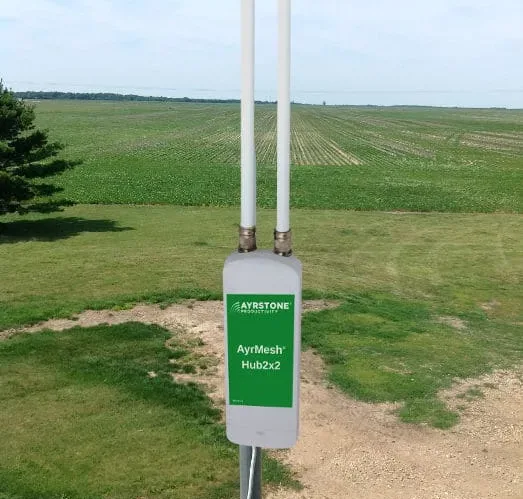The latest innovations in farming include sensors to monitor weather conditions, control irrigation, GPS to track the supply chain, and software to automate business processes. It all needs reliable, strong Wi-Fi.
The Best Farm Wi-Fi Solutions (2025)

Large farming operations require real-time data across extensive acreage and multiple properties. Reliable internet solutions power the technology to do it. | Image by iStock
Can you get Wi-Fi solutions on a farm?
Modern farming is highly dependent on the latest equipment and communication tools to operate efficiently and smoothly. A reliable internet connection is essential for maintaining synchronization and delivering accurate data, with strong Wi-Fi to bridge it across the property. Whether it’s monitoring autonomous equipment, running security cameras, or managing day-to-day business operations, high-speed Wi-Fi is critical.
However, establishing a connection that reliably runs throughout your properties can be challenging. You need an internet provider that can deliver fast speeds in rural locations, and preferably one that provides unlimited data for a fair value. Then, you need to connect everything through a strong Wi-Fi signal, which is another challenge. Here’s what we’ve found.
Long-range farm Wi-Fi solutions
Once you’ve selected your ideal farm internet provider, you need to determine how to deploy it throughout your operation, a particularly challenging task due to the large, multi-property nature of agriculture. Here are our recommended options.
Budget: Outdoor Wi-Fi extenders
One of the simplest ways to spread Wi-Fi across your farm is to set up an outdoor Wi-Fi extender—or a whole system of them.
Wi-Fi extenders pick up your existing network’s signal and boost it using an antenna built into the extender equipment. There are several types (and they’re sometimes referred to as Wi-Fi antennas, Wi-Fi repeaters, etc.), but these are the best suited for outdoor use and are typically affordable.
*As of 7/13/2023.
Mid-Range: Mesh Wi-Fi Systems (Asus ZenWi-Fi)
Outdoor Wi-Fi extenders are great, but a mesh Wi-Fi system is more reliable and better suited for businesses that require strong, far-reaching connectivity. Mesh Wi-Fi systems, unlike extenders and repeaters, broadcast the original signal from multiple points, acting as a network of routers that create a stronger and larger signal area.
The Asus ZenWi-Fi system provides significantly better signal coverage over larger areas than a Wi-Fi extender can, and it’s our recommendation for the easiest and most convenient mesh system option for establishing farm Wi-Fi. The ASUS Wi-Fi 6 version is affordable and powerful enough to cover medium-sized farms, and is easily scalable as your operations grow.

Arystone Hubs placed throughout large properties communicate with each other and broadcast Wi-Fi. | Image by Ayrstone
Ayrstone is a full-scale farm connectivity solution designed specifically for agriculture in rural geographic areas. It touts its easy-to-install and maintain equipment, which is fully scalable to vast properties. It offers a small suite of products dedicated to helping you establish a solid, wireless farm internet connection, including outdoor Wi-Fi hubs for extending the signal into the farthest fields, indoor hubs for connecting your outbuildings, and receivers to connect your field equipment to the network.
Get Wi-Fi in your tractor cab, keep your land secure with wireless cameras, and even maintain a fleet of autonomous vehicles that are reliably connected to your network. The Ayrmesh Hubs are designed to stretch a signal for several miles with multiple hubs. Equipment is designed to be weather-resistant and capable of operating in most conditions. Additionally, its hubs are solar power-ready. The best place to start is with the Hub 2x2.
Best farm internet providers
There are several solutions for getting internet in rural locations, and the industry for rural internet has undergone considerable innovations, with one of the impressive types of providers being satellite internet.
Satellite internet - For the most remote farms
Satellite internet providers have been rapidly improving and are now being used by farmers everywhere to ensure their businesses remain connected. Satellite internet is available to 99 percent of the U.S., and has proven to be a reliable connection. The three satellite internet providers currently available are Hughesnet, Starlink, and Viasat. Each offers business-oriented plans that provide priority service and support; however, depending on the scope of your operation, your needs, and location, a residential plan may also be a suitable option.
Starlink is currently the only satellite internet provider that can be used on the move with Starlink Roam, allowing you to connect autonomous equipment directly to a speedy internet connection if Wi-Fi is unavailable.
Fixed-wireless internet - For affordable, unlimited data
Fixed-wireless internet has also been on the rise and has become more accessible in rural locations, leveraging far-reaching 5G networks. The country’s largest mobile carriers all offer internet services, with business plans and products tailored to both small and enterprise-sized companies. It’s a type of internet that’s also ideal for rural businesses when wired connections are scarce.
*w/ Auto Pay and qualifying mobile plan. Regulatory fees included in monthly price for qualified accounts. See full terms.
**w/ Auto Pay. Available in select areas.
***Consumer data usage is subject to the usage restrictions set forth in Verizon's terms of service; visit: https://www.verizon.com/support/customer-agreement/ for more information about 5G Home and LTE Home Internet or https://www.verizon.com/about/terms-conditions/verizon-customer-agreement for Fios internet.
Fiber/Cable -Speedy internet and the preferred choice if available
Fiber is by far the fastest internet solution and is typically very affordable. It requires significant investment to build out its infrastructure, especially in rural areas. However, if it is an option for your farm, it’s a reliable and lightning-fast internet option that’s perfect for any business.
Why is reliable internet essential for modern farming?
The U.S. agricultural industry benefits greatly from implementing modern networking technology and practices, keeping farms competitive with new ways of operating the business. Whether it’s for improved security, better communication, data gathering and analysis, or automation, a reliable internet provider and network are essential for keeping businesses efficient and profitable.
The latest innovations in farming include sensors to monitor weather conditions, control irrigation, GPS to track the supply chain, and software to automate business processes. Overcome the challenges of getting a strong internet connection to your farm with highly available satellite internet, reliable fixed-wireless internet, or speedy fiber and cable connections.
Getting Wi-Fi on your farm FAQ
Can I install Wi-Fi in rural areas?
Anyone can install Wi-Fi in a rural area, but your options may be limited depending on your precise location. You can often find Spectrum in rural areas, and satellite internet can be set up in 99% of the U.S., for example.
If you want to convince an internet provider to lay internet infrastructure in your rural area, you can reach out to an internet service provider and offer to pay up-front for the infrastructure, or you can form a co-op and together with your neighbors split the upfront costs to get better internet options.
Why is it so hard to get Wi-Fi out in rural areas?
Internet service providers (ISPs) have to build out expensive infrastructure in order to bring internet access to a certain area, and unfortunately, because rural areas typically have fewer people spaced further apart, ISPs get much better return on investment from cities. Fortunately, with satellite internet services like Starlink, Viasat, and Hughesnet, even rural areas can get internet access as long as there’s a clear view of the southern sky.


